- REPORTER: Say, is he working on a case?
- NORA: Why, yes –
- REPORTER: What case is it?
- NORA: A case of Scotch. Go in and help him.
I rarely venture into hard-boiled territory, but I have always had a deep fondness for Dashiell Hammett. I bought myself a copy of his Five Collected Novels years ago in order to read The Maltese Falcon. However, it made sense to simply read the novels in order and so I began with Red Harvest (1929), which I have re-read twice and find something new to savor with each revisit. I think its setting, Poisonville, could be the model for every dark noir town in literature and film, as well as Twin Peaks and other settings that ooze moral decay. There’s something almost epic about it. I would love to figure out how to dramatize it for the stage.
Next I tackled The Dain Curse (also 1929), Hammett’s most underrated puzzler, with a dazzling reveal at the end. The Maltese Falcon (1930), among other things, explains why Hammett had the potential to be a successful screenwriter. The dialogue in the brilliant third adaptation of the novel (starring Bogart, Astor, Lorre and Greenstreet) is lifted verbatim from the book, and it crackles. It’s a shame he only wrote four films, but more about that anon.
The fourth novel, The Glass Key (1931), is considered by some to be Hammett’s masterpiece. For some unearthly reason, I have not yet read it. Perhaps I felt subconsciously that I should save a morsel for the future.
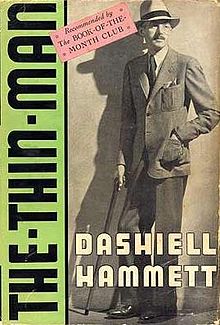
Which leaves The Thin Man, published in 1934, after which Hammett forsook novel writing for the final thirty years of his life. Red Harvest lays bare the corruption of the working class, The Dain Curse paints a tawdry picture of religious cults, Falcon bestows upon us the ultimate femme fatale, and amidst the tawdry world of corrupt politics, The Glass Key is an ode to friendship. But The Thin Man is a soufflé, a romance disguised as a mystery, presenting what may have been Hammett’s purest vision of true love: two people going through life drunk on gin and glamor, romance and rye, and catching murderers together along the way. There’s a sense of happiness pervading this novel that you find in no other long work of Hammett’s: perhaps, after writing it, he simply burned himself out. At least, he stopped writing novels, but he recognized the potential popularity of Nick and Nora Charles as continuing characters and allowed Metro Goldwyn Mayer to adapt the novel to film and to create five sequels. To add the cherry on top, the author himself penned the treatments to the first two sequels. Yes, the studio should probably have stopped there, since films four through six show a marked decrease in quality. But the first three films are classics, the progenitors of the screwball mystery film, and combined with the novel, they are perfect subject matter for the Tuesday Night Bloggers’ February subject: Love (and Murder) in Bloom.

First, some administrative duties: as host of this month’s festivities, I am responsible for linking you to my fellow TNB’er’s posts for the week.
Here was Week 1.
Here was Week 2.
And here are today’s posts:
Moira at Clothes in Books puts the finishing touch on her year-long read of all the novels comprising the sexy career of Brad Friedm- er, James Bond:
And Kate at Cross Examining Crime has compiled a marvelous list of her favorite sleuthing couples.
Speaking of which . . .
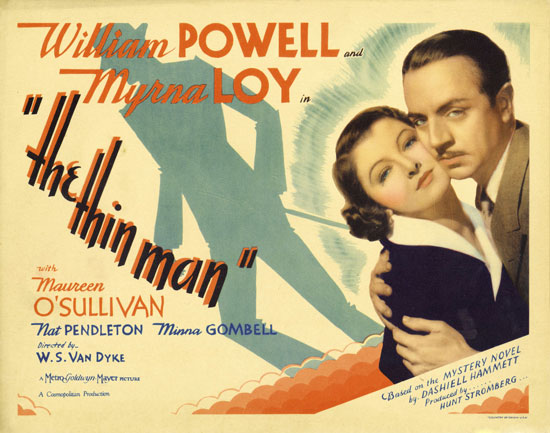
So let’s get this straight: does everybody understand that the protagonist of The Thin Man, retired detective Nick Charles, is not the title character? The Thin Man is an inventor named Clyde Wynant, who goes missing one day, and whose daughter Julia hires Nick to find him. Charles is reluctant because he has given up the game and has married the beautiful and wealthy socialite, Nora, “for her money,” he says. But he agrees to help Julia and gets drawn into a bizarre case involving the grotesque Wynant family, their satellites, and a bunch of gangsters. The mystery is fine, but its no Maltese Falcon. It has neither the darkness nor the clever twists of the earlier novels. However, that is not really the point here. The point is Nick and Nora Charles, who coast along on a tide of booze and flippancy, along with their beloved lady schnauzer, Asta. It would make total sense for Nora to be horrified at her husband’s antics, at his wealth of low-life friends, most of whom he had a hand in putting away, and at his propensity to put himself in danger. Instead, Nora encourages and even becomes a willing participant in the game. The pair are equals in every way, and if Nick occasionally tries to elude Nora for her safety, you get the sense that he’s relieved when she tracks his scent and finds him. One can guess that there’s a lot of autobiographical connection going on here: Hammett himself was a retired detective who had taken up with a witty sexual partner in playwright Lillian Hellman before he wrote the novel. Their stormy relationship would last for the rest of his life. The sexual undertone in the novel is evident but never coarse, and it lessens the sense of true danger we find in Hammett’s other writing. If that arguably makes The Thin Man feel like a lesser work, it is also a pure delight to read.
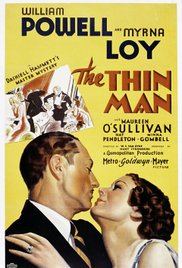
And to watch! MGM bought the rights and treated the whole project lovingly (if frugally). First, they hired Albert Hackett and Frances Goodrich, a married team, as screenwriters. The couple brought a wonderful flavor to Nick and Nora’s banter. They understood how couples talk and how families interact, a skill that would be evident here and in future projects like It’s a Wonderful Life (1946), Father of the Bride (1950) and the Lucille Ball-Desi Arnaz comedy, The Long, Long Trailer (1954). It would all culminate in their Pulitzer Prize-winning play The Diary of Anne Frank, which they adapted to film in 1959.
The director, W.S. Van Dyke, was a veteran of the silent era who brought Nick and Nora to life through the first four of the six films in the series. At the same time, he made stars out of Jeannette McDonald and Nelson Eddy in six films, and he immortalized another great couple, Tarzan and Cheetah, er, Jane, in 1932’s Tarzan the Ape Man. (From that film, he pulled its Jane, Maureen O’Sullivan, to play Dorothy Wynant in The Thin Man.) It was Van Dyke who insisted that MGM cast the stars of his early 1934 hit, Manhattan Melodrama, the classic storyline of boyhood friends whose lives diverge when one becomes a D.A. and the other a gangster, and then they are brought back together through love for the same woman. In William Powell and Myrna Loy, Van Dyke knew he had the perfect Nick and Nora.
The film is less a murder mystery than a treatise on heavy drinking with a whodunit chaser. Author Danny Reid collected a wealth of marvelous essays in a book called Thoughts on The Thin Man. In one, Michael James Roberson counts the number of drinks Nick Charles consumes:
“ . . . 33 drinks in the novel, (about one every six pages) and 21 in the film (about one every four minutes). Like fellow Hammett protagonist Sam Spade, who consumes a rather heroic amount of gin over the course of The Maltese Falcon, the Nick of the novel never seems to really get drunk . . . “

William Powell, however, plays Nick throughout “sleepy-eyed . . . with a mildly detectable slur and a slight wobble in his step.” Loy is much more alert, although she is just as fond of a cocktail. Her chemistry with Powell is palpable. They loved working with each and made 14 films together. Fans thought they really were a couple!
The oddest casting, perhaps was Skippy, a male Wire Fox Terrier, who was cast as the female schnauzer, Asta. He was a thoroughly entertaining dog, but where Powell and Loy were great to work with, Skippy was something of a diva and bit his leading lady during filming.
The first half hour of the film concentrates on the mystery and is heavy with shadows, a progenitor of the films noir of the 1940’s and ‘50’s. In the brief time he is on screen, Edward Ellis shows us every side to Wynant’s personality: the eccentric scientist, the loving father, and the enraged . . . well, you name it – Wynant is cheated, cuckolded, and robbed and means to put a stop to this losing streak. We meet Clyde’s estranged family, including his ex-wife Mimi (superbly played by Minna Gombell, a fine character actress whose 30 year career should be more well known) and his morbid son Gilbert (William Henry.) Even though this film was made pre-Production Code, the characters were cleaned up from the novel. Gilbert, for example, is obsessed with psychology and death in the movie, while in the novel he also experiments with drugs.
At the ten minute mark, Dorothy and her fiancé attend a rollicking party at a posh speakeasy on Christmas Eve and run into an old friend: Nick Charles, who is teaching the bartenders how to make a perfect martini and is first scene from the point of view of his backside, elegantly samba-ing with a cocktail shaker. A minute later, Loy makes an even more impressive entrance on the end of Asta’s leash. I have a mad passion for Myrna Loy (and for Sylvia Sydney! Both of them looked a great deal like my grandmother.) Nora assesses Nick’s level of inebriation and quickly drinks him under the table. Then some more mystery intrudes on the fun. We meet the Charles’ again at a party they’re giving, and there will be many more gatherings like this in future films, where the well-to-do hob nob with recently released convicts and other shady characters. There’s always a guest of two bragging about how Nick put him away for ten years, (“That’s okay, I needed the rest!”), and now they are the best of friends.
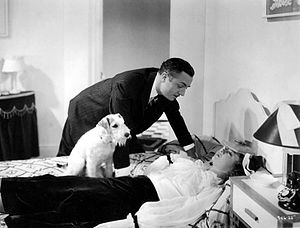
One can’t accuse The Thin Man of focusing too hard on the puzzle, but bad things happen to balance out Nick’s binges and Nora’s enjoyment of them. The film ends like the novel, with Nick gathering the suspects together for a dinner party and, in true Golden Age fashion, sorting through the case until he unmasks the killer. That person’s identity will not be revealed here, but their place in the storyline became the template for the sequels that followed, so that, by the end, any fan of the series will suffer from a feeling of sameness regarding the murder plots and their resolutions.
At any rate, The Thin Man was a big success and prompted a 1936 sequel, After the Thin Man. It takes place immediately following the first film, as Nick and Nora travel back to their home in San Francisco just in time to try to help Nora’s cousin Selma track down her missing husband. The dialogue was again written by the team of Hackett and Goodrich, with characters and storyline by Hammett himself, and the supporting cast is even better. Nora’s family may not be as dysfunctional as the Wynants, but they are colorful characters and a real thorn in Nick’s side. Once again, family members co-mingle uneasily with gangsters, a trademark of the series, and the final reveal gives us a killer who is both surprising and highly unlikely!
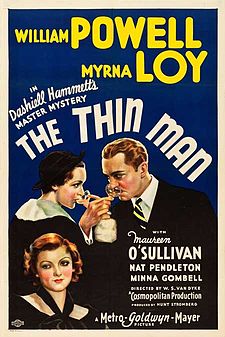
My favorite of the series is the third film, Another Thin Man (1939). At the end of the previous film, Nick and Nora are on a train, and Nick notices Nora knitting booties. I guess that means that “another” refers to their infant son, Nicky Jr., who at the start of the third film is wearing the booties. Hammett again supplies the story, and Goodrich and Hackett the screenplay, based on a short story by Hammett called The Farewell Murder. Once more, the Charles’ traverse the country and wind up on Long Island where they visit a former business associate of Nora’s late father. Murder ensues again and again and again before Nick uncovers my favorite killer of the lot. A great cast, including C. Aubrey Smith, Sheldon Leonard, and Ruth Hussey make up a colorful array of suspects and victims, although by now the communion between the upper crust and the gangster class is starting to wear a bit thin.
By the time the fourth film rolled around, the formula was becoming just that: formulaic. It was Van Dyke’s last film in the series as he fell prey to cancer and heart disease (he took his own life in 1943). Hammett and the screenwriters were no longer associated with the series, and even Powell and Loy seemed tired of playing the Charles’. The mysteries were paper thin, padded with too much tired comedy. However, it’s easy to criticize them, and one has to point out that they’re still enjoyable to watch. Nick and Nora Charles would appear again, both on the radio and on TV as series characters, and even star in a failed musical. The fad for love detectives, like the Lockridges Mr. and Mrs. North and Kelley Roos’ Jeff and Haila Troy, grew through the 1940’s and 50’s, and we have Nick and Nora Charles to thank for it. Theirs was a love that could withstand an onslaught of homicides and highballs!
So glad you’re highlighting this great couple, Brad! Nick and Nora Charles are terrific together, both in the novel and in the films, and I always liked their dynamic. One of those couples you just can’t resist liking.
LikeLike
It’s very much a fantasy, Margot, when we learn how alcohol destroyed Hammett’s life. I have never been much of a drinker, so I just go along with that part. What’s really great is how much Nick and Nora are equal partners, how deeply they love each other, and how funny they are about expressing it! (Oh, and Asta never stops being their child, even when little Nicky is born! Just as it should be! 🙂 )
LikeLiked by 1 person
A thoroughly enjoyable piece about my all-time favorite movie(s)! Thank you!
LikeLike
I love your authorial handle! 🙂
LikeLike
I love Nick and Nora. Powell and Loy were magical together, a perfect screen fit.
LikeLike
I agree! Few pairings matched the power and longevity of their chemistry! Only Hepburn and Tracy come to mind off the top of my head!
LikeLike
Agreed, I wish they had made even more films together. I also think Hepburn and Cary Grant, and Walter Pidgeon and Greer Garson had terrific chemistry.
LikeLike
What a great choice for the Love theme! So long since I read this or saw the film, and tbh I remember almost nothing except that I loved both, back then. Time to revisit without a doubt.
LikeLike
Pingback: LARCENY IN LAVENDER: Curtis Evans’ Murder in the Closet | ahsweetmysteryblog
I adore Hammett and love the Thin Man. I was happy after I read the book, to learn that the movie is, for all its tongue-in-cheekishness, was faithful to the material. I was sad that Hammett never wrote any sequels. The third Thin Man Film, “Another Thin Man” was loosely based on Hammetts “The Farewell Murder”, but that’s as close as it got to a true Hammett “sequel.”
The movies adapted “The Thin Man” title and used it for all the sequels, thereby creating the confusion about to whom the title line referred. (This also was the fate of “Prime Suspect” which didn’t refer to criminal suspects, but Jane Tennison herself; and Game of Thrones, whose series title is from the first book in the saga The Song of Fire and Ice (Guess GOT sounded snappier)).
If you haven’t read “The Glass Key” you really should — it’s some fine characterizations and a great mystery. The movie version with Brian Donlevy, was excellent as well. Highly recommend. But do read the book.
Overall, I thought “The Maltese Falcon” was overrated as a mystery — (ducks) but it was a good solid crime novel (too many gangsters and guns for my taste).
Hammett was an awesome talent and funnily enough, as different as his actual writing style is, I get Hammett’s ghost whilst reading Elroy…funny or what?
LikeLiked by 1 person
I know I should read Ellroy, but funnily enough I haven’t! I will get to Glass Key one of these days!
LikeLiked by 1 person